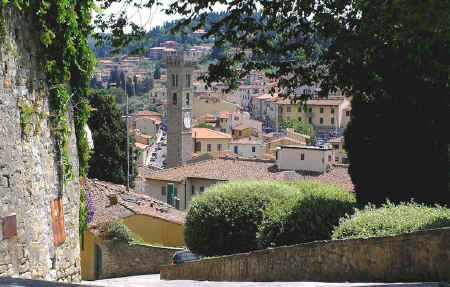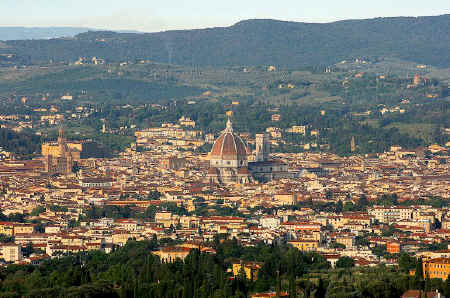
A day trip from Florence to Fiesole is a must for any visitor to this part of Tuscany, Italy. Aside from the sights of interest within and near Fiesole itself, on a sunny day the view from the Fiesolean hills out over Florence is spectacularly beautiful. Fiesole can be reached by car or bus, and also (for the fit only) on foot along narrow walled roads past numerous fine villas, including the Villa Medici at Fiesole. How to reach Fiesole, Italy, by public transportThe ATAF Florence city bus to Fiesole is Number 7 which runs about every half an hour until almost midnight so that it is possible to remain in Fiesole for dinner. The bus line starts at Via La Pira (on the side very close to Piazza San Marco) in Florence.
Fiesole - a brief historyFiesole is of Etruscan origin, as may be seen from the remains of its ancient walls, and was probably founded in the 9 C BC. One possible reason for the prosperity of Etruscan and Roman Fiesole could be its location near a ford over the Arno close to where Roman Florence (Florentia) would rise. Fiesole's location also made it strategic for travellers on all the main roads between southern and central Etruria to the south of Italy (covering large parts of present day Tuscany, Umbria and Latium) and the Etruscans in the area around the Po valley to the north of Italy. Travel Guide for Visitors to the Chianti Classico Wine Region of Tuscany, Italy.
The Romans conquered Faesulae, as Fiesole was then known, in 283 BC. Under Roman
rule, it became the seat of a famous school of augurs,
and every year twelve young men were sent here from Rome to study the
art of divination. Rome typically drew heavily on the Etruscans for
priests and augurs. Sulla colonised it with veterans, who afterwards,
under the leadership of Manlius, supported the cause of Catiline. Near
Fiesole, the Vandals and Suevi under Radagaisus were defeated (405) by
hunger rather than by the troops of Stilicho. A considerable number of interesting finds from the Etruscan period - urns, bucchero, clay and bronze statues - together with other objects from Roman times are to be found in the Museum near the archaeological zone.  Florence and the Duomo viewed from Fiesole
The Cathedral of St. Romulus was built in 1028 by Bishop Jacopo
Bavaro with materials taken from several older buildings and it contains
notable sculptures by Mino da Fiesole. The old cathedral became a
Benedictine abbey, and in course of time passed into the hands of the
regular canons of Lateran. It once possessed a valuable library, long
since dispersed. The abbey was closed in 1778. The famous
Vallombrosa Monastery
is within the Diocese of Fiesole although not near the town. Fiesole, Italy - things to see
the Badia or ancient
cathedral at the foot of the hill on which Fiesole stands, supposed to
cover the site of the martyrdom of St. Romulus. the room in the
bishop's palace where St. Andrew Corsini lived and died.
the little
church of the Primerana in the cathedral square, where St. Andrew Corsini
was warned by Our Lady of his approaching death.
the church of S. Alessandro, with the shrine of St. Alexander, bishop and
martyr.
the monastery of S. Francesco on the crest of the hill, with the cells of St. Bernardine of Siena and seven Franciscan Beati. |
Monastery of San Francesco, Fiesole
S. Domenico, the novice-home of Fra Angelico da
Fiesole
and of St. Antoninus of Florence. The roads that lead from Florence to the hill of Fiesole all converge on the plateau where the church of San Domenico stands, annexed to the convent which was founded in 1406. The Renaissance layout of the building was transformed between the end of the
16 C and the beginning of the 17 V by Dosio (tribune and choir) and Matteo Nigetti (porch on the facade and bell tower). The complex contains a wealth of works of art:
outstanding among them are various paintings by Fra Angelico,
whose novice home it was. St. Antoninus of Florence, Bishop of Florence in the first half of the
15 C, also stayed there, as well as Fra Domenico Buonvicini who was burned at the stake with Savonarola in 1498. Fontanelle, a villa near
S. Domenico where St. Aloysius came to live in the hot summer months,
when a page at the court of Grand Duke Francesco de' Medici. Fonte Lucente, where a miraculous crucifix is greatly revered. A few miles distant is Monte Senario, the cradle of the Servite Order, where
its seven holy founders lived in great austerity and were cheered at
their death by the songs of angels - or so some believe. S. Martino di Mensola, with the body of St. Andrew, an Irish saint, still intact. Villa Medici at Fiesole - more about this archetypical Tuscan villa.
On the other side of the valley of the Arno is the beautiful romanesque church of San Miniato al Monte. |
|
North of Florence on a hill next to Fiesole, the Vincigliata Castle is of medieval origin but owes its current appearance to the complete reconstruction in neogothic style that was carried in the last century. The owner at that time, John Temple Leader, commissioned the architect Giuseppe Fancelli to rebuild the castle and the work was finished in 1865.More about Vincigliata Castle. |
Roman baths and theatre at Fiesole, Italy
web site design, hosting and promotion by ammonet
Fiesole © ammonet InfoTech 1998 - 2024. All rights reserved.